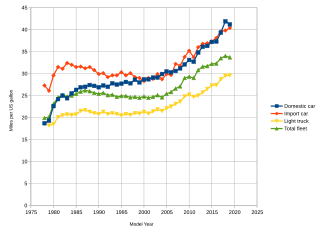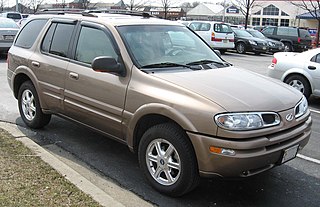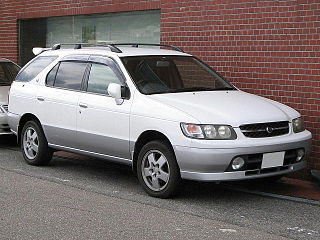
The Honda CR-X, originally launched as the Honda Ballade Sports CR-X in Japan, is a front-wheel-drive sport compact car manufactured by Honda from 1983 until 1991 with nearly 400,000 produced during this period. The first-generation CRX was marketed in some regions outside Japan as the Honda Civic CRX. Although there are many supposed definitions for the initialism CR-X, the most widely accepted is "Civic Renaissance Experimental".

Corporate average fuel economy (CAFE) standards are regulations in the United States, first enacted by the United States Congress in 1975, after the 1973–74 Arab Oil Embargo, to improve the average fuel economy of cars and light trucks produced for sale in the United States. More recently, efficiency standards were developed and implemented for heavy-duty pickup trucks and commercial medium-duty and heavy-duty vehicles. CAFE neither directly offers incentives for customers to choose fuel efficient vehicles nor directly affects fuel prices. Rather, it attempts to accomplish the goals indirectly, by making it more expensive for automakers to build inefficient vehicles by introducing penalties.

The Honda Insight is a hybrid electric vehicle that is manufactured and marketed by Honda. Its first generation was a two-door, two passenger liftback (1999–2006) and in its second generation was a four-door, five passenger liftback (2009–2014). In its third generation, it became a four-door sedan (2018–2022). It was Honda's first model with Integrated Motor Assist system and the most fuel efficient gasoline-powered car available in the U.S. without plug-in capability for the length of its production run.

The Oldsmobile Bravada is a mid-size luxury SUV that was sold by Oldsmobile from 1991 to 2004. The only SUV ever marketed by Oldsmobile, the Bravada was the first light truck offered by General Motors outside of the Chevrolet and GMC divisions since 1924. The flagship of the GM midsize SUV line, the Bravada served as the most luxurious GM SUV prior to the introduction of the GMC Yukon Denali and Cadillac Escalade.

The Toyota RAV4 EV is an all-electric version of the popular RAV4 SUV produced by Toyota until 2014. Two generations of the EV model were sold in California, and to fleets elsewhere in the US, with a gap of almost ten years between them.

The Ford Fusion Hybrid is a gasoline-electric hybrid powered version of the mid-sized Ford Fusion sedan manufactured and marketed by Ford, which had two generations. A plug-in hybrid version, the Ford Fusion Energi, was released in the U.S. in February 2013. The last model year for all Ford Fusions was 2020.
The General Motors Ultralite was a 1992 low emission vehicle concept car intended to demonstrate the benefits of advanced materials and low fuel consumption.

The Ford C-Max is a car produced by the Ford Motor Company from 2003 to 2019. It has a five-door compact multi-purpose vehicle (MPV) design. The Ford Grand C-Max has a longer wheelbase.

The Saturn Aura is a four-door, five-passenger front engine/front-wheel drive mid-sized sedan manufactured and marketed by GM's Saturn subsidiary over a single generation from 2006 to 2009. The car launched one year before the seventh generation Chevrolet Malibu, its most closely related platform companion.

The Acura RDX is a compact luxury crossover SUV produced by Acura, a luxury vehicle division of Honda, as the second crossover SUV offering from the brand after the mid-size MDX. Since it was introduced, it has shared its platform with the Honda Civic and CR-V.
Shell Eco-marathon is a world-wide energy efficiency competition sponsored by Shell. Participants build automotive vehicles to achieve the highest possible fuel efficiency. There are two vehicle classes within Shell Eco-marathon: Prototype and UrbanConcept. There are three energy categories within Shell Eco-marathon: battery-electric, hydrogen fuel cell, and internal combustion engine. Prizes are awarded separately for each vehicle class and energy category. The pinnacle of the competition is the Shell Eco-marathon Drivers' World Championship, where the most energy-efficient UrbanConcept vehicles compete in a race with a limited amount of energy.

The Nissan R'nessa is a station wagon manufactured by Nissan Motors from 1997 to 2001. According to Nissan, the name derives from "packaging renaissance for versatile, spacious comfort on wheels."

The Saturn Relay is a minivan that was marketed by the Saturn division of General Motors. It was introduced for the 2005 model year, and was built alongside its badge-engineered variants—the Buick Terraza, the Chevrolet Uplander, and the Pontiac Montana SV6—in Doraville, Georgia.

The fuel economy of an automobile relates to the distance traveled by a vehicle and the amount of fuel consumed. Consumption can be expressed in terms of the volume of fuel to travel a distance, or the distance traveled per unit volume of fuel consumed. Since fuel consumption of vehicles is a significant factor in air pollution, and since the importation of motor fuel can be a large part of a nation's foreign trade, many countries impose requirements for fuel economy.
The energy efficiency in transport is the useful travelled distance, of passengers, goods or any type of load; divided by the total energy put into the transport propulsion means. The energy input might be rendered in several different types depending on the type of propulsion, and normally such energy is presented in liquid fuels, electrical energy or food energy. The energy efficiency is also occasionally known as energy intensity. The inverse of the energy efficiency in transport is the energy consumption in transport.

The Honda CR-Z is a sport compact hybrid electric car manufactured by Honda and marketed as a "sport hybrid coupe." The CR-Z combines a hybrid gasoline-electric powertrain with traditional sports car elements, including a 2+2 seating arrangement and a standard 6-speed manual transmission.

The H-M-Vehicles Free-Way was a three-wheel microcar manufactured in Burnsville, Minnesota, from 1979 to 1982.

Miles per gallon gasoline equivalent is a measure of the average distance traveled per unit of energy consumed. MPGe is used by the United States Environmental Protection Agency (EPA) to compare energy consumption of alternative fuel vehicles, plug-in electric vehicles and other advanced technology vehicles with the energy consumption of conventional internal combustion vehicles rated in miles per U.S. gallon.

The BMW E31 is the first generation of the BMW 8 Series. It is a grand tourer built by BMW from 1990 to 1999 as a 2-door coupé, powered by either a V8 or V12 engine. Whilst it did supplant the original E24 based 6 Series in 1990, it was not a direct successor, but a new model class with a substantially higher price and performance than the 6 Series.

The third generation Honda CR-V was launched for the 2007 model year. It went on sale in the U.S. during late September 2006. Unlike preceding models, it features a rear liftgate rather than a side-opening rear door and no longer has the spare tire mounted on the rear door. The new CR-V is lower, wider and shorter than the previous models; the length decrease is attributed mostly to the fact that the spare wheel no longer adds length to the back of the vehicle. A lowering of the centre of gravity is another benefit of the spare wheel being located underneath the rear cargo area. The centre rear seat pass-through was also introduced as a new feature on the third generation.

















